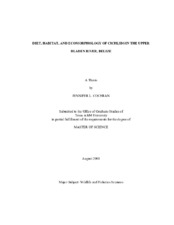| dc.description.abstract | Cichlids are among the most species rich and ecologically diverse families of
freshwater fishes. Life history attributes vary greatly among cichlids across their global
range, and in the Neotropics alone studies have revealed a great deal of diversity in cichlid
ecology, morphology and behavior. This study investigated the habitat use, diet, and
ecomorphology of an assemblage of cichlids in the Upper Bladen River, Belize.
Mesohabitats, including riffles, runs, deep pools, vegetated areas and adjacent streams,
were surveyed and snorkeled, and physicochemical and habitat variables were measured at
each site where cichlids were observed or collected. Between 12 and 65 stomachs of each
cichlid species were analyzed for diet composition. In addition, traditional morphometrics
were completed on five individuals of each species in order to investigate the relationships
between morphology, diet, and habitat use. The present study revealed patterns of trophic
and morphological diversity consistent with a hypothesis of resource partitioning in
accordance with adaptive divergence in morphological traits that influence ecological
performance. The Bladen cichlid assemblage has one algivore with a long, coiled gut
(Archocentrus spilurus), one piscivore with an elongated body and highly protrusbile jaws
(Petenia splendida), two substrate sifters that feed extensively on benthic invertebrates
(Astatheros robertsoni and Thorichthys meeki), one midwater invertebrate feeder ('Cichlasoma' salvini), and one large-bodied, trophic generalist (Vieja maculicauda).
Species in this assemblage display divergent ecological patterns supported by
morphological and behavioral adaptations that yield a degree of diet and habitat
segregation. The present study provides not only basic ecological data essential for
effective conservation, but also evidence of niche diversification within a local assemblage
of heroine cichlids that will be useful for ecological and evolutionary analyses at larger
scales of taxonomy, geography, and time. | en |


